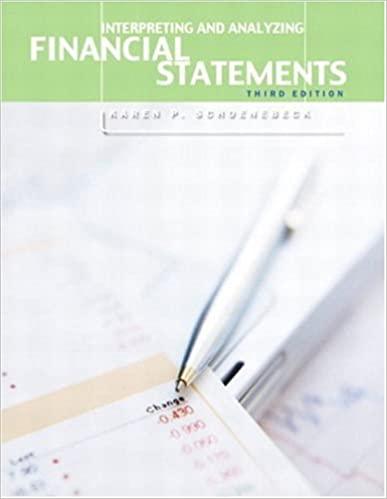Question
Medallion Cooling Systems, Inc., has total assets of $ 9 comma 600 comma 000$9,600,000, EBIT of $ 2 comma 020 comma 000$2,020,000, and preferred dividends
Medallion Cooling Systems, Inc., has total assets of
$ 9 comma 600 comma 000$9,600,000,
EBIT of
$ 2 comma 020 comma 000$2,020,000,
and preferred dividends of
$ 198 comma 000$198,000
and is taxed at a rate of
40 %40%.
In an effort to determine the optimal capital structure, the firm has assembled data on the cost of debt, the number of shares of common stock for various levels of indebtedness, and the overall required return on investment:
| Capital structure debt ratio | Cost of debt, r Subscript drd | Number of common stock shares | Required return, r Subscript srs |
| 0 %0% | 0 %0% | 201 comma 000201,000 | 12.3 %12.3% |
| 1515 | 8.18.1 | 169 comma 000169,000 | 13.313.3 |
| 3030 | 8.78.7 | 143 comma 000143,000 | 13.813.8 |
| 4545 | 11.811.8 | 112 comma 000112,000 | 16.216.2 |
| 6060 | 15.115.1 | 80 comma 00080,000 | 19.819.8 |
a. Calculate earnings per share for each level of indebtedness.
b. Use the equation
Upper P 0 equals EPS divided by r Subscript sP0=EPS/rs
and the earnings per share calculated in part
(a)
to calculate a price per share for each level of indebtedness.
c. Choose the optimal capital structure. Justify your choice.
a. Calculate earnings per share for each level of indebtedness.
Calculate the EPS below: (Round to the nearest dollar. Round the EPS to the nearest cent.)
| Debt Ratio |
| 0% |
| EBIT | $ | 2,020,000 |
| Less: Interest | $ |
|
| EBT | $ |
|
| Taxes @40% | $ |
|
| Net profit | $ |
|
| Less: Preferred dividends | $ |
|
| Profits available to |
| |
| common stockholders | $ |
|
| # shares outstanding | $ | 201,000 |
| EPS | $ |
|
Calculate the EPS below: (Round to the nearest dollar. Round the EPS to the nearest cent.)
| Debt Ratio |
| 15% |
| EBIT | $ | 2,020,000 |
| Less: Interest | $ |
|
| EBT | $ |
|
| Taxes @40% | $ |
|
| Net profit | $ |
|
| Less: Preferred dividends | $ |
|
| Profits available to |
| |
| common stockholders | $ |
|
| # shares outstanding | $ | 169,000 |
| EPS | $ |
|
Calculate the EPS below:(Round to the nearest dollar. Round the EPS to the nearest cent.)
| Debt Ratio |
| 30% |
| EBIT | $ | 2,020,000 |
| Less: Interest | $ |
|
| EBT | $ |
|
| Taxes @40% | $ |
|
| Net profit | $ |
|
| Less: Preferred dividends | $ |
|
| Profits available to |
| |
| common stockholders | $ |
|
| # shares outstanding | $ | 143,000 |
| EPS | $ |
|
Calculate the EPS below:(Round to the nearest dollar. Round the EPS to the nearest cent.)
| Debt Ratio |
| 45% |
| EBIT | $ | 2,020,000 |
| Less: Interest | $ |
|
| EBT | $ |
|
| Taxes @40% | $ |
|
| Net profit | $ |
|
| Less: Preferred dividends | $ |
|
| Profits available to |
| |
| common stockholders | $ |
|
| # shares outstanding | $ | 112,000 |
| EPS | $ |
|
Calculate the EPS below: (Round to the nearest dollar. Round the EPS to the nearest cent.)
| Debt Ratio |
| 60% |
| EBIT | $ | 2,020,000 |
| Less: Interest | $ |
|
| EBT | $ |
|
| Taxes @40% | $ |
|
| Net profit | $ |
|
| Less: Preferred dividends | $ |
|
| Profits available to |
| |
| common stockholders | $ |
|
| # shares outstanding | $ | 80,000 |
| EPS | $ |
|
b. The price per share for the
0 %0%
level of indebtedness is
$nothing.
(Round to the nearest cent.)The price per share for the
15 %15%
level of indebtedness is
$nothing.
(Round to the nearest cent.)The price per share for the
30 %30%
level of indebtedness is
$nothing.
(Round to the nearest cent.)The price per share for the
45 %45%
level of indebtedness is
$nothing.
(Round to the nearest cent.)The price per share for the
60 %60%
level of indebtedness is
$nothing.
(Round to the nearest cent.)
c. Choose the optimal capital structure. Justify your choice. (Select the best answer below.)
A.The optimal capital structure would be
15 %15%
debt and
85 %85%
equity because this is the debt/equity mix that maximizes the price of the common stock.
B.The optimal capital structure would be
45 %45%
debt and
55 %55%
equity because this is the debt/equity mix that maximizes the price of the common stock.
C.The optimal capital structure would be
60 %60%
debt and
40 %40%
equity because this is the debt/equity mix that maximizes the price of the common stock.
D.The optimal capital structure would be
30 %30%
debt and
70 %70%
equity because this is the debt/equity mix that maximizes the price of the common stock.
Step by Step Solution
There are 3 Steps involved in it
Step: 1

Get Instant Access to Expert-Tailored Solutions
See step-by-step solutions with expert insights and AI powered tools for academic success
Step: 2

Step: 3

Ace Your Homework with AI
Get the answers you need in no time with our AI-driven, step-by-step assistance
Get Started


